Among the deepest mysteries of ancient Egypt 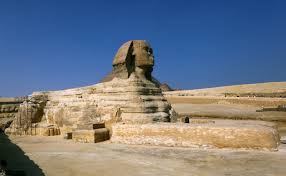 is the Great Sphinx of Giza. Researchers, both professional and amateur, have painstakingly investigated its every aspect.8 Yet key puzzles remain, above all the question of why this colossal structure, the ancient world’s largest monument, was built in the first place.
is the Great Sphinx of Giza. Researchers, both professional and amateur, have painstakingly investigated its every aspect.8 Yet key puzzles remain, above all the question of why this colossal structure, the ancient world’s largest monument, was built in the first place.
It’s not that serious researchers and free-ranging speculators have not proposed explanations. But every theory put forward falls well short of true persuasiveness or stumbles over inconvenient facts. Here are three anomalies a correct theory should explain.
First, why is the Sphinx so much longer than a real lion or than other sphinxes? Some Egyptologists explain this as necessitated by weakness in the rock structure, but that explanation does not address the possibility that the elongation might convey some meaning. It also doesn’t account for the length of the paws that stretch out to the front. In addition, several observers have suggested that something originally was located in between or in front of the paws. Later, various structures were inserted there, so that we will probably never know for sure. But such an object might make the monument even longer.
Second, remnants of red ochre-hued paint have been traced back to painting of the Sphinx long after its original construction as it came to be a major monument to Re Horakhty, the sun god Horus of the Two Horizons. It seems reasonable to suppose that the Sphinx was painted red initially, and that the later painting simply renewed its known color. But why red? Lions are not red.
Third, why would anyone conceive of this project and wish to build it? Is there something about the date of the original construction of the Sphinx that fits both the elongation and the redness? Was something going on that would motivate a pharaoh to order such a gigantic monument to be built?
Dating the Sphinx has been the subject of a long controversy. Most Egyptologists cite inscriptions, statuary, and other evidence connecting the pyramid behind the Sphinx and the associated temples with Khafre (Cephren). A generally reliable source dates his reign to 2520-2494 BC.9 They interpret the prior quarrying of the nearby stone for Khufu’s earlier pyramid and the close-by undisturbed causeway to Khafre’s pyramid as meaning that the Sphinx was built during his reign. Most think that the Sphinx’s face, minus the nose, is probably his. Various Egyptologists hold that it could have been finished under his successors, and a few have argued that it might have been initially constructed earlier in the IVth Dynasty.
The main serious scholarly challenge to the professional consensus was mounted by geologist Robert Schoch, who argued that the monument’s exterior shows signs of major water damage from rainfall that must have occurred in previous millennia, given the dry climate of Giza at and since the building of the great pyramids. But critics, including geologists, have noted that the Sphinx’s near-burial in moist sand could have done the damage, that dew causes ongoing limestone flaking, that the area was wetter at the time of the construction of the pyramids and only turned drier several centuries later, and that occasional rains still fall.10 It is hard to find an Egyptologist who accepts Schoch’s arguments and chronology.
Since late antiquity there have been claims by casual observers, dedicated amateur researchers, psychics, and others that there are hidden chambers beneath the Sphinx that contain secret writings. In the current main such theory, the construction goes back to 10500 BC when the original pyramids later attributed to Khufu, Khafre, and Menkaure were allegedly aligned to imitate the three stars of the belt of Orion. The theory argues that these pyramids and the original ancestor of the Sphinx were built by a superior civilization (some say Atlantis), and that the present Sphinx represents a remodeling of the original one.11 Professional Egyptologists unanimously reject this, but it resonates with people of a certain outlook.
Clearly, it would be helpful to arrive at a fully persuasive explanation of the Sphinx. In fact, there is one, but it requires understanding what was going on around the world when the Sphinx was built. And that necessitates setting aside preconceived notions.
A Key Reinterpretation
In his 1950 book Worlds in Collision12, Immanuel Velikovsky argued that Venus had emerged from Jupiter and repeatedly approached Earth during the Bronze Age. New evidence and reinterpretation make it clear that Velikovsk y was basically right. Venus did not emerge from Jupiter but was rather pulled by its immense gravity from outer space. Turned into a molten comet by tidal heating, Venus headed into the inner solar system. It approached Earth every 52 years and on four occasions came close enough to cause major catastrophes reported by the ancients. Now we know their approximate dates: 2200, 1628, 1210, and 820 BC. In Book III of The Histories, Herodotus wrote that Egyptian priests had told him that four times since Egypt became a kingdom “the Sun rose contrary to his wont; twice he rose where he now sets, and twice he set where he now rises.” This was interpreted by Velikovsky to mean that the world had inverted at the times of the catastrophes. He attributed the inversions to electromagnetic forces between Venus and Earth, but a gravitational interaction seems an adequate explanation.
y was basically right. Venus did not emerge from Jupiter but was rather pulled by its immense gravity from outer space. Turned into a molten comet by tidal heating, Venus headed into the inner solar system. It approached Earth every 52 years and on four occasions came close enough to cause major catastrophes reported by the ancients. Now we know their approximate dates: 2200, 1628, 1210, and 820 BC. In Book III of The Histories, Herodotus wrote that Egyptian priests had told him that four times since Egypt became a kingdom “the Sun rose contrary to his wont; twice he rose where he now sets, and twice he set where he now rises.” This was interpreted by Velikovsky to mean that the world had inverted at the times of the catastrophes. He attributed the inversions to electromagnetic forces between Venus and Earth, but a gravitational interaction seems an adequate explanation.
Velikovsky thought that Venus first approached Earth around 1500 BC, but now we know that it was shortly before 2500 BC—the time that the Sphinx was constructed, according to the evidence assembled by the Egyptologists. The initial interaction between Venus and Earth evidently stirred up a great deal of interplanetary dust from Venus’ tail as well as dust in Earth’s atmosphere. These made Venus appear red, as it appears in iconography. The shock of interaction and the appearance of a giant red comet rising in the eastern sky would have inspired awe and put fear into millions of people worldwide, including Khafre.
Thus, according to this explanation, Khafre ordered the construction of a gigantic effigy of Venus facing eastward toward the rising planet-comet in front of his pyramid and using the rock next to Khufu’s quarry. Khafre had a big ego; the name of his pyramid was “Khafre is great”. So it seems that the face of the Sphinx was Khafre’s.
As an 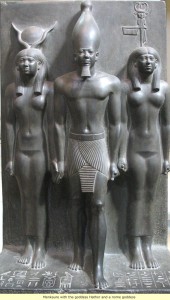 effigy, the purpose of the Sphinx appears to have been to signal to Venus above that Khafre and his people were devoted to the planet-comet god, to say “We’re on your team! Please spare us.”, so to speak. This explains why the Sphinx was so large and why it imitated Comet Venus in length and color. But the imitation went farther. The body of Comet Venus blocked sunlight from the center of its tail, at least immediately behind the planet-comet, so that what appeared were two shining trails on the sides. The peoples of the Near East saw them as horns and called Venus the bull of heaven. In Egypt Venus became the preexisting cow goddess Hathor (later it was also assigned to Isis, and over time Hathor merged into Isis), as in this depiction of Khafre’s successor Menkaure between his wife and Hathor.
effigy, the purpose of the Sphinx appears to have been to signal to Venus above that Khafre and his people were devoted to the planet-comet god, to say “We’re on your team! Please spare us.”, so to speak. This explains why the Sphinx was so large and why it imitated Comet Venus in length and color. But the imitation went farther. The body of Comet Venus blocked sunlight from the center of its tail, at least immediately behind the planet-comet, so that what appeared were two shining trails on the sides. The peoples of the Near East saw them as horns and called Venus the bull of heaven. In Egypt Venus became the preexisting cow goddess Hathor (later it was also assigned to Isis, and over time Hathor merged into Isis), as in this depiction of Khafre’s successor Menkaure between his wife and Hathor.
In the headdresses of Egyptian queens, two thick bars imitated the double tail of Venus, as in this image of Nefertari (ca 1250 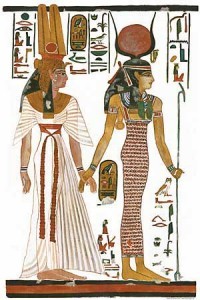 BC) being led by Isis. Note that the red ball in Nefertari’s headdress is more circular, while that in Isis’ headdress is oval. In ancient times Venus was ovoid, as depicted in iconography and in the layouts of astronomical sites, because it had turned molten while passing Jupiter and was almost pulled in two by Jupiter’s gravity. However, because Venus was never far from the Sun, because over the centuries it gradually lost its tail in encounters with Earth and Mars as well as becoming less ovoid, and because over time cultural amnesia caused memory loss, Venus could easily be overshadowed by the Sun. So early depictions of Venus as a red oval were gradually replaced in iconography by red circles interpreted as suns.
BC) being led by Isis. Note that the red ball in Nefertari’s headdress is more circular, while that in Isis’ headdress is oval. In ancient times Venus was ovoid, as depicted in iconography and in the layouts of astronomical sites, because it had turned molten while passing Jupiter and was almost pulled in two by Jupiter’s gravity. However, because Venus was never far from the Sun, because over the centuries it gradually lost its tail in encounters with Earth and Mars as well as becoming less ovoid, and because over time cultural amnesia caused memory loss, Venus could easily be overshadowed by the Sun. So early depictions of Venus as a red oval were gradually replaced in iconography by red circles interpreted as suns.
Thus we can construe the long front paws of the Sphinx as the double tail of Venus as in the queens’ headdresses. In between the paws is an empty, darker area, as with the darkened portion of Venus’ tail behind the body of the planet. Then comes the rest of the Sphinx, as with the long tail of Venus following the darkened portion with the two bright edges. The only thing missing would then be the red oval depicting Venus itself, in front of the paws.
For 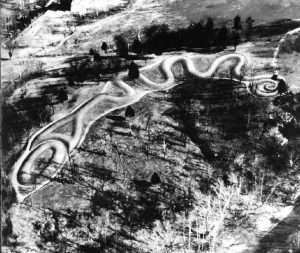 comparison, it is useful to view another effigy of Venus—the Great Serpent Mound in Ohio. There we see that, behind the mouth of the serpent with the egg comes a dark triangular area that represented the dark area of the cometary tail behind planet Venus. Then the two sides of the tail blend into one. None of this proves that there was an original oval depiction of Venus in front of the Sphinx’s paws. But, even though assuming that it was indeed there is not required to accept the Venus effigy interpretation of the Sphinx, the notion certainly seems suggestive.
comparison, it is useful to view another effigy of Venus—the Great Serpent Mound in Ohio. There we see that, behind the mouth of the serpent with the egg comes a dark triangular area that represented the dark area of the cometary tail behind planet Venus. Then the two sides of the tail blend into one. None of this proves that there was an original oval depiction of Venus in front of the Sphinx’s paws. But, even though assuming that it was indeed there is not required to accept the Venus effigy interpretation of the Sphinx, the notion certainly seems suggestive.
As far as dating the Sphinx is concerned, the Venus effigy interpretation supports Egyptologists’ ascription of the Sphinx to Khafre, or just before 2500 BC. The construction of the main megalithic stage of Stonehenge in the years around 2500 BC further buttresses this finding because we now know that Stonehenge included an effigy of Venus and an oval. In addition, various observers have noted that in Khufu’s pyramid, which is generally of excellent quality, some of the presumably late construction seems downright shoddy and even some well-built parts have never been brought to a logical conclusion. Meanwhile, Khafre’s pyramid also uses high-quality stones and construction for several courses, but from there on the construction materials are poor.13 It seems reasonable to think that the late construction stage of Khufu’s pyramid coincided with the early stage of Khafre’s, and that a catastrophic approach of Venus around 2520 BC disrupted the construction and perhaps killed or incapacitated the master architect(s), leading to a sharp decline in quality.
Catastrophes caused by approaches of Venus every 52 years may have deposited volcanic ash that, mixed with dew, caused leaching of the surface of the Sphinx as Schoch and others argue.
Meanwhile, the Sphinx Temple in front of the Sphinx uniquely contains two sanctuaries.14 For worshipping the Morning Star and Evening Star!
Re Horakhty and Sekhmet
If Venus made such an impression when it first approached Earth, why did the Sphinx lose its association with Venus over time? One reason has already been suggested—that the Sun appropriated functions and symbols of Venus. But something else also occurred.
From the t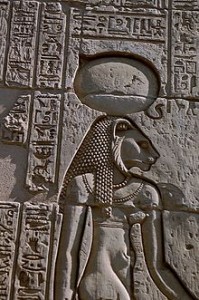 ime of the catastrophic first inversion of Earth around 2200 BC, the Sun and Venus began to rise in the west. This continued throughout the First Intermediate Period and the Middle Kingdom until the second inversion around 1628 BC, when they switched back to rising in the east. During this long period, the Sphinx became the center of the new cult of Re Horakhty, Horus of the Two Horizons. This name is commonly taken to refer to the Sun rising in the east and setting in the west, but in the context of inversions it refers rather to the Sun that was capable of rising in either the east or the west. It became the term for the Sun when it rose in the west. No longer pointing in the right direction to greet the rising Venus, the Sphinx lost its connection to Venus; the loss of tradition in the turmoil of the First Intermediate Period also played a role. Instead, the Sphinx came to be seen as the embodiment of the western rising Sun, Re Horakhty, facing east as he moved eastward. However, the original link between Venus and a lion (indicative of the ferocity of Venus in causing catastrophes) seems to have persisted in the form of the terrifying lion-headed goddess Sekhmet, companion and protector of the Sun. The oval atop her head in the picture is generally called a sun-disk.
ime of the catastrophic first inversion of Earth around 2200 BC, the Sun and Venus began to rise in the west. This continued throughout the First Intermediate Period and the Middle Kingdom until the second inversion around 1628 BC, when they switched back to rising in the east. During this long period, the Sphinx became the center of the new cult of Re Horakhty, Horus of the Two Horizons. This name is commonly taken to refer to the Sun rising in the east and setting in the west, but in the context of inversions it refers rather to the Sun that was capable of rising in either the east or the west. It became the term for the Sun when it rose in the west. No longer pointing in the right direction to greet the rising Venus, the Sphinx lost its connection to Venus; the loss of tradition in the turmoil of the First Intermediate Period also played a role. Instead, the Sphinx came to be seen as the embodiment of the western rising Sun, Re Horakhty, facing east as he moved eastward. However, the original link between Venus and a lion (indicative of the ferocity of Venus in causing catastrophes) seems to have persisted in the form of the terrifying lion-headed goddess Sekhmet, companion and protector of the Sun. The oval atop her head in the picture is generally called a sun-disk.
But we may think otherwise.
*****
Kenneth J. Dillon is a historian who writes about science, medicine, and history. See the biosketch at About Us. For further detective work on ancient and modern history, see his The Knowable Past (2nd edition, Washington, D.C.: Scientia Press, 2019).
